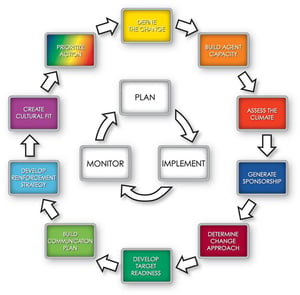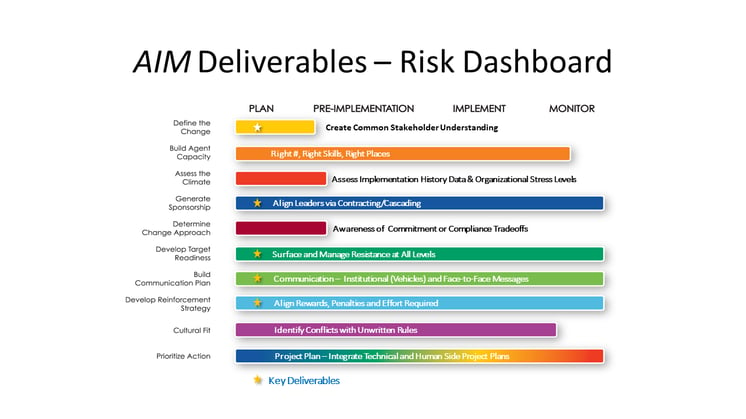We’ve all heard the statistic 70% of all organizational change projects fail. This figure was first reported by Hammer and Champy in 1993 and, unfortunately, recent research confirms the staggering statistic hasn’t changed by much. The ugly truth of the matter is today’s organizations are still plagued by projects that are sub-optimized, if not facing outright failure. “Spotty” implementations are all too common with success in one area  but not in all areas impacted by the change.
but not in all areas impacted by the change.
Why is this still happening? And more importantly how can we change the narrative so that our business projects get to value optimization each and every time? Believe it or not, the answer is relatively easy. In order to get to full value realization, the people side of a project needs to be managed with the same rigor and discipline as the technical side. {Tweet This}
The Human Side of the Equation
There are 5 metrics that must be met on every project in order to deem it successful:
- It’s delivered on time
- It’s delivered on budget
- The technical objectives are achieved
- The business objectives are achieved
- AND it meets the human objectives that have been established for the change
Contrary to popular belief, the greatest risk for failure or sub-optimization is actually on the human side of the equation, not the technical side. In our 35+ years of change management consulting we’ve seen plenty of sub-optimal human side issues that have led to failed attempts at change. Here are just a few examples:
- End users don’t adopt new processes or use work-arounds rather than accept new tools/methods so operational efficiencies aren’t realized
- There is weak accountability in the middle layers of the organization for implementation success
- Resistance generated from the degree of work disruption is left unmanaged and slows down change
- Old reinforcements are applied that don’t match new expectations
- Leaders at all levels don’t take an active role in change implementation
The Answer: Integration of Change Management and Project Management 
To fight back against the plague of sub-optimized projects, organizations need to apply the same discipline and rigor on the people side of a project as they do the technical side. In other words, they need to integrate a structured change management framework like the Accelerating Implementation Methodology (AIM) into their project management protocols.
The AIM Change Management methodology was developed with this concept in mind. When you look at the 10 core change management principles depicted in AIM’s road map, you will see they surround the project management elements of Plan, Implement and Monitor. In AIM, the human elements of a project are meant to be blended with the project management approach from the very beginning.
The below chart describes AIM’s 10 core elements and how they fit into Project Management:

What if You are Using Agile?
It is no different in an Agile environment. The integration of change management and project management should still start at the beginning. Running the two plans in parallel, or waiting until each "sprint" is over, and then handling the people side of the project is not going to work.
Instead, AIM’s 10 core change management principles need to be incorporated into each “sprint.” The project team must be prepared to apply situational strategies to manage the people side risks in real time. Questions such as these will need to continually asked:
- Is the Definition of the Change still accurate, and are Sponsors and Agents aligned?
- Where is Sponsorship needed?
- Where will we have resistance, and how will we manage it?
- What do we need to communicate, when, and how?
- What reinforcements are needed to drive the change to sustained, full implementation?
Whether you are using Agile or a more traditional Waterfall approach to project management, the end goal should be the same…value realization. With the amount of business capital being spent on large scale, complex changes who can afford to have a 70% failure rate? By integrating change management into project management protocols, project managers will have the tools to manage the human objectives of the change with the same level of rigor as applied to the technical objectives leading to successful implementations…at speed. And that's the truth!


